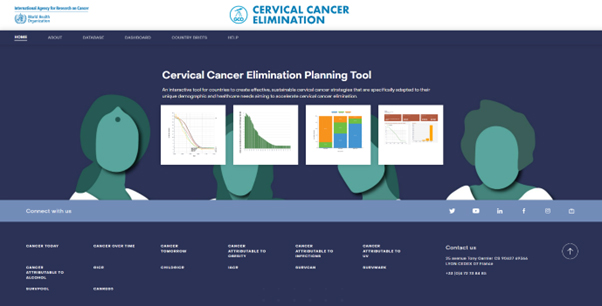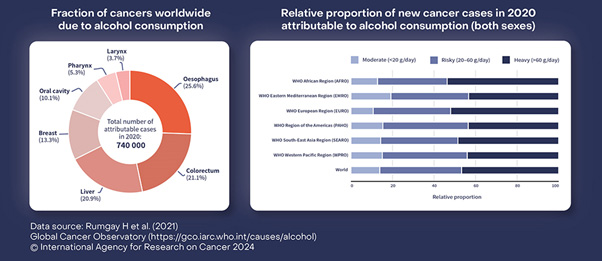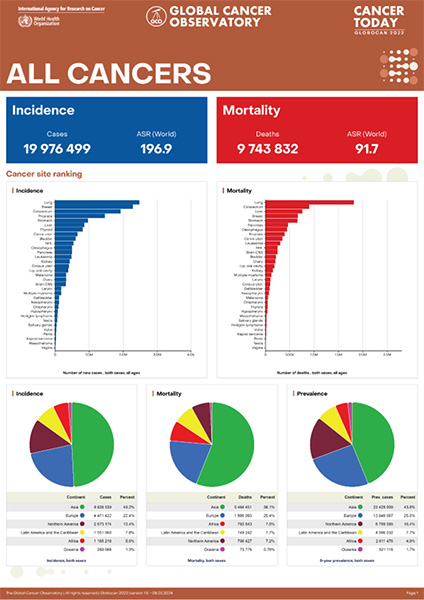Research
- The IARC Initiative for Resilience in Cancer Control (IARC-IRCC)
- Global survival benchmarking
- The societal impact of cancer, beyond traditional measures
- Estimating the future cancer burden and the impact of cancer control measures
- Cancer in children and adolescents
- Childhood cancer registration
- Social inequalities and cancer
- Descriptive economics of cancer
- Provision of global public databases
- Scaling up cancer registry activities for better data through the GICR
CSU is involved in many collaborative studies seeking to describe and interpret the changing magnitude and the transitional nature of cancer profiles around the world, through observation of variations by geography and over time. Key areas of activity include:
- Enhancing understanding of global, regional, national, and subnational changes in cancer risk and survival and their determinants, including in relation to ongoing socioeconomic transitions and social inequalities.
- Generating scientific evidence related to the effectiveness of implementing primary prevention interventions, including the prevention or reduction of exposure to established modifiable risk factors.
- Enhancing understanding of the economic impact of cancer, to ensure equitable and sustainable health systems that are capable of effectively reducing the burden of cancer.
Selected current projects within CSU are described below.
The IARC Initiative for Resilience in Cancer Control (IARC-IRCC)
The IARC Initiative for Resilience in Cancer Control (IARC-IRCC), previously known as the IARC COVID-19 and Cancer Initiative, was launched in 2020 through a request from CSU to the IARC Governing Council and the IARC Scientific Council to support IARC in investigating the impact of the COVID-19 pandemic on cancer services, including health system disruptions and mitigation strategies.
To capture crises globally, the activities planned within the initiative have been expanded to include natural and human-made disasters. The updated major aims of the initiative cover three overarching workstreams:
- Conduct in-depth monitoring of key indicators of cancer incidence, survival, and mortality during and after future crises linked to pandemics or other major events.
- Explore reasons for disruptions to cancer services and effective mitigation strategies.
- Provide a tool to model the short-, medium-, and long-term impact of disruptions on cancer outcomes, to improve resilience in cancer control.
The launch of the Cervical Cancer Elimination Planning Tool, a global modelling platform on the Global Cancer Observatory, is part of this Initiative.
- SURVMARK. Provision of up-to-date survival measures, and systematic approaches to understanding the impacts of registry processes and stage in transitioned countries. The SURVMARK-3 project is now under way as part of the third phase of the International Cancer Benchmarking Partnership (ICBP). SURVMARK-3 will provide an overview of cancer control progress versus existing survival inequalities across ICBP countries.
- SURVCAN. Global synthesis of comparable survival statistics in transitioning countries, with an emphasis on bilateral collaborations with registries to ensure complete follow-up of patients. Cancer Survival in Transitioning Countries (SURVCAN-4) is being developed to estimate cancer survival among people diagnosed with cancer in 2013–2020, with follow-up to the end of 2021, in at least 30 transitioning countries.
The societal impact of cancer, beyond traditional measures
- Studies quantifying the proportion of cancer cases attributable to risk factors (updates or new factors: body mass index, smoking including smokeless tobacco use, physical inactivity, infectious agents, and ultraviolet radiation).
- PREVENT 2.0 seeks to quantify the impact of specific preventive interventions on cancer incidence in the Nordic countries (with a focus on reductions in tobacco smoking, alcohol consumption, and high body mass index), including assessments of the public health impact on cancer mortality and the corresponding economic impact. The results will be integrated into NORDCAN.
- ALMACAN (ALcohol MArketing restrictions to reduce the burden of CANcer in Europe) will assess the effects of alcohol marketing restrictions on alcohol consumption and the subsequent impact on the burden of alcohol-related cancer.
- Estimation of the burden of cancer using disability-adjusted life years (DALYs).
- Prevalence by phase of care. A global update of methods to better identify the needs of patients with cancer and attach economic costs.
Estimating the future cancer burden and the impact of cancer control measures
- Meeting global noncommunicable disease (NCD) targets. Using mortality trends to predict future premature deaths from cancer and other NCDs, as well as the contribution of risk factors and prevention strategies in achieving United Nations Sustainable Development Goals targets.
- Dynamic models to predict the long-term future burden under scenarios of roll-out of screening and vaccination programmes.
- Tobacco control and alcohol control: impact of prevention policies on the long-term burden of related cancers.
Cancer in children and adolescents
- The Cancer Risk in Childhood Cancer Survivors (CRICCS) project, funded by Children with Cancer UK, aims to better understand causes, to lead to targeted prevention strategies, via peer-reviewed publications and further dissemination of:
-
- Estimates of childhood cancer prevalence in Europe.
- Estimates of the risk of second primary neoplasms among childhood cancer survivors.
Under the collaborative agreement between St. Jude Children’s Research Hospital and IARC, titled Targeting Childhood Cancer through the Global Initiative for Cancer Registry Development (ChildGICR), CSU aims to drive various activities to improve and expand childhood cancer registration through the following activities:
- Implementation in countries. The aims of implementation are to develop country-specific guidelines, set targets, and develop a follow-up plan, in line with international standards and with the involvement of national stakeholders.
- Education strategy. After an assessment of education needs, educational content is being developed in collaboration with national experts, members of the GICR network of regional trainers.
- Research. Selected challenges are being analysed to strengthen the quality and availability of data on cancer in children. The ongoing areas of research are:
-
- barriers to data sharing and the development of best practices;
- classification of childhood central nervous system tumours, and registration of non-malignant central nervous system tumours;
- the financial burden borne by families affected by cancer in a child; and
- quantification of the cost of registration of cancer in children.
Social inequalities and cancer
- Descriptive epidemiology of social inequalities in cancer, including:
- developing a research and data framework to study socioeconomic inequalities in cancer;
- integrating indicators into the European Cancer Inequalities Registry; and
- assessing inequalities in cancer mortality by education, sex, age, and residence.
- Overdiagnosis and overtreatment (thyroid cancer, melanoma, prostate cancer, kidney cancer, breast cancer).
- SEIC-Sweden: the financial burden of socioeconomic inequalities in cancer. Quantifying the extent to which inequalities have impacts on the total economic burden by health region in Sweden.
Descriptive economics of cancer
Cancer is one of the leading causes of death worldwide and a rapidly growing area of health-care expenditure. Costs of cancer are expected to continue to increase, because of population growth, ageing, and the arrival of novel and expensive cancer medicines, which are comparably more expensive than non-cancer medicines. In view of these issues, data on cancer costs are in high demand for policy-makers. However, to date, few studies have examined the total cost of cancer to the health system, how costs have evolved over time, the contribution of different factors such as cancer type and areas of expenditure, or how countries compare with respect to the economic efficiency of cancer care. In this area of work, CSU aims to:
- Estimate the productivity losses due to cancer-related premature mortality and morbidity from cancer at the global, regional, and national levels.
- Estimate health expenditure costs from cancer across countries.
- Estimate informal health-care costs for cancer at the global, regional, and national levels.
- Perform priority-setting in cancer prevention and control. Collaborations with WHO and partners to assist national policy-makers to obtain the best value for money by identifying priority interventions in cancer planning and evaluating the impact, cost, and feasibility of a package of interventions according to country capacity.
Other related activities within CSU
Provision of global public databases
-
GLOBOCAN 2022. The global estimates for 2022 are included in the Cancer Today subsite of the Global Cancer Observatory. These estimates are updated every 2 years, based on the most recently available recorded data worldwide. The release of new estimates is accompanied by an open access article assessing regional variations in cancer incidence and mortality.
- Cancer Incidence in Five Continents, Volume XII (CI5-XII). The latest volume is now available in PDF format. CI5-XII has a wider coverage than any previous volume, presenting high-quality standardized data for cancers diagnosed during the period 2013–2017 from 460 cancer registries in 65 countries. The data published in all 12 volumes of CI5 are also accessible on the CI5 website, where users can explore the incidence figures and trends using online analysis tools.
- Global Childhood Cancer database (ChildCan). Based on the International Incidence of Childhood Cancer (IICC) series, national estimates of childhood cancer incidence are being developed according to the International Classification of Childhood Cancer (ICCC) and selected diagnostic subgroups.
- Integrating research findings into the Global Cancer Observatory platform. Indicators developed through CSU’s research are being integrated through infographics and interactive tools, accompanied by short excerpts from the research articles.
Scaling up cancer registry activities for better data through the Global Initiative for Cancer Registry Development (GICR)
The GICR was established to coordinate activities that increase the quality, availability, and use of cancer data worldwide. Together with a leading group of partners, the GICR is helping transitioning countries to build their capacity to collect local cancer data, synthesize the data, and disseminate findings, so that targeted actions can be taken to tackle the rising cancer burden. Current activities include:
- Expansion of PBCR development and outputs by Regional Hubs: partner country agreements, partners (e.g. WHO headquarters and regional offices, leading to more robust data for national cancer control plans and GLOBOCAN estimation).
- The GICR e-Learning Series. This has been designed to provide comprehensive training in the principles and practices of cancer registration. The 16 online modules cover the essentials of cancer registration – an overview introduction, data collection, coding, data management, and analyses – and provide theory, standards, and guided skill instruction on specific implementation steps.
- New electronic tools and reference works are being developed, including online learning modules and standardized slides, with appropriate linkages to the IACR and WHO.





